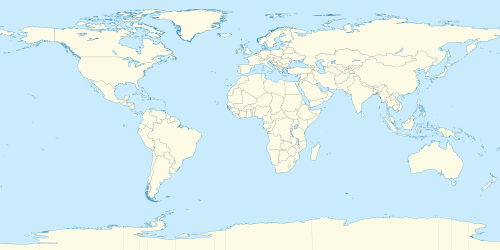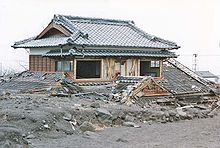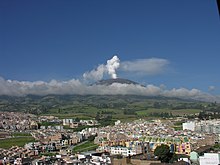
The Decade Volcanoes are 16 volcanoes identified by the International Association of Volcanology and Chemistry of the Earth's Interior (IAVCEI) as being worthy of particular study in light of their history of large, destructive eruptions and proximity to densely populated areas. The Decade Volcanoes project encourages studies and public-awareness activities at these volcanoes, with the aim of achieving a better understanding of the volcanoes and the dangers they present, and thus being able to reduce the severity of natural disasters.
They are named Decade Volcanoes because the project was initiated in the 1990s as part of the United Nations–sponsored International Decade for Natural Disaster Reduction.
A volcano may be designated a Decade Volcano if it exhibits more than one volcanic hazard (people living near the Decade Volcanoes may experience tephra fall, pyroclastic flows, lava flows, lahars, volcanic edifice instability and lava dome collapse); shows recent geological activity; is located in a densely populated area (eruptions at any of the Decade Volcanoes may threaten tens or hundreds of thousands of people, and therefore mitigating eruption hazards at these volcanoes is crucial); is politically and physically accessible for study; and there is local support for the work.
Aims of the program

The general approach of Decade Volcano projects has been to convene a planning workshop, identify the major strengths and weaknesses of risk mitigation at each volcano, and to plan how to address the weaknesses identified. One of the difficulties faced in mitigating hazards at volcanoes is ensuring that geoscientists and those who will enact the mitigation measures communicate adequately with each other, and the Decade Volcano program has attempted to ensure this by making sure both groups are well represented at Decade Volcano workshops.

Funding

Hopes that United Nations funding might be available for Decade Volcano projects did not come to fruition, and funding was sought instead from a variety of sources. For example, Mexican scientific and civil defence bodies funded work at Colima, principally for Mexican scientists but also for a few foreign colleagues; major bilateral French-Indonesian and German-Indonesian programs were initiated at Merapi; and the European Union has provided funding for many of the studies carried out at European volcanoes.
One particular activity that has not been funded—because it typically is not allowable under most national or bilateral funding—is the exchange of scientists and civil defence leaders between the various Decade Volcano projects of developing countries, for example, between the Philippines and Indonesia, or between Mexico, Guatemala, and Colombia, or across the Pacific and Atlantic. Often, scientists and civil defence leaders from developing countries can relate better to each other's experiences than they can to the experience of counterparts from industrialized countries. Also, civil defence leaders who have experienced volcanic crises are far more credible witnesses, in the eyes of local civil defence leaders, than either local or visiting scientists might be.
Achievements

Since it was initiated, the Decade Volcano program has achieved a number of successes in predicting volcanic events and mitigating disasters. One of the most notable was the successful diversion of a lava flow and blanket at Mount Etna in 1992. The flow was threatening the town of Zafferana, and had overwhelmed several barriers placed perpendicular to its flow down a valley. Scientists and civil defence leaders decided to try to dam the flow higher up, and did so by dropping large concrete blocks into a skylight in a lava tube which was feeding the flow. The flow subsequently stopped short of Zafferana.
The program has significantly increased what is known about the Decade Volcanoes, some of which were very poorly studied before being designated. The eruptive history of Galeras volcano is now much better established than previously, and at Taal Volcano the importance of water in driving its explosive eruptions has come to light.
Measures which have been taken to mitigate disasters which might be caused by future eruptions include a new law in the vicinity of Mount Rainier, requiring assessment of geological hazards before any new developments; limitations on high density housing developments in the Taal Caldera; and the development of an evacuation plan for parts of Naples which might be affected in the event of an eruption at Vesuvius.
Problems

Although studies at many Decade Volcanoes have clearly reduced the risks faced by nearby settlements, eruptions at some of the Decade Volcanoes have demonstrated the difficulties faced by the program. Eruptions at Japan's Mount Unzen which began shortly before it was designated a Decade Volcano were heavily monitored, but despite this, a large pyroclastic flow killed 43 people, including three volcanologists.
Later, a 1993 Decade Volcano conference in the city of Pasto, Colombia ended in disaster when several attending scientists mounted an impromptu expedition to the crater of Galeras. An unexpected eruption while they were at the summit killed six scientists and three tourists.
Civil unrest in the vicinity of several of the Decade Volcanoes has also interfered with the program. The civil war in Guatemala affected studies of Volcán Santa María until a ceasefire was called in 1996, while ongoing civil war in the Democratic Republic of the Congo has hampered studies of Nyiragongo volcano. More generally, scarce resources for volcano studies have led to programs competing for limited funding.
Volcanoes selected

The following volcanoes were selected as the 16 current Decade Volcanoes:
| Volcano | Elevation | Region | Country | Population at risk of lava/lahar /ash flow |
Last known eruption | Affected Region/Why a Decade Volcano |
|---|---|---|---|---|---|---|
| Avachinsky-Koryaksky | 2,741 m (8,993 ft) (Avachinsky) 3,456 m (11,339 ft) (Koryaksky) |
Kamchatka | Russia | 179,367 (2021 est) |
2001 (Avachinsky),
2009 (Koryaksky) |
Proximity of volcano to Petropavlovsk-Kamchatsky. |
| Volcán de Colima | 3,820 m (12,533 ft) | Colima/ Jalisco | Mexico | 770,000 (2019 est) |
2019 | Whole of Colima State |
| Galeras | 4,276 m (14,029 ft) | Nariño | Colombia | 1,630,000 (2018 est) |
2014 | Whole of Nariño Department |
| Mauna Loa | 4,169 m (13,678 ft) | Hawaii | United States | ? | 2022 | Largest of the active shield volcanoes in the Hawaiian Islands. Lower flanks populated in multiple directions, but most dangerous to the city of Hilo |
| Mount Etna | 3,326 m (10,912 ft) | Sicily | Italy | 1,100,000 | 2013–present | Whole metro city of Catania in general due to air pollution and ash clouds. Capable of lava bombs and violent VEI 3 eruptions. |
| Mount Merapi | 2,910 m (9,547 ft) | Central Java/ Special Region of Yogyakarta | Indonesia | 5,050,000 (2019 est) |
2024 | Whole of Special Region of Yogyakarta, and Klaten Regency |
| Mount Nyiragongo | 3,470 m (11,385 ft) | North Kivu | Democratic Republic of the Congo | 2,000,000 | 22 May 2021 – present, VEI 0-2. | No census for decades in sprawling city of Goma. Lava known to be highly fluid and fast-moving. May 2021 eruption killed 32 people and injured thousands. Currently not monitored for seismic activity. |
| Mount Rainier | 4,392 m (14,409 ft) | Washington | United States | 795,000 (2010) |
1894-1895, (minor phreatic) | Whole of Pierce County, and potentially as far as Seattle. Mount Rainier is one of the most glaciated stratovolcanoes in the Cascade Volcanic Arc. Capable of setting off massive lahars, as evidenced in the valleys below it in all directions. Known to have had both landslide type lahars or snowmelt lahars. Considered by USGS to be one of the most dangerous volcanoes in the USA. |
| Mount Vesuvius | 1,281 m (4,203 ft) | Campania | Italy | 3,085,000 | 17-23 March 1944, VEI 3 | Whole metro city of Naples. Very long record of destroying cities nearby, capable of large pyroclastic flows. Destroyed Herculaneum and Pompeii in 79 AD, VEI 5 eruption. |
| Mount Unzen | 1,486 m (4,875 ft) | Nagasaki/ Kumamoto | Japan | 1,320,000 (2019 est) |
1995 | Nagasaki Prefecture, tsunami potential |
| Sakurajima | 1,117 m (3,665 ft) | Kagoshima | Japan | 1,470,000 (2019 est) |
2022 | Whole of Kagoshima Prefecture except Amami Islands |
| Santa María | 3,772 m (12,375 ft) | Quetzaltenango | Guatemala | 1,127,000 (2018 est) |
23 August 2013 | Whole of Quetzaltenango and Retalhuleu Departments |
| Santorini (Thera) | 367 m (1,204 ft) | South Aegean | Greece | ? | 1950 | Entire island of Santorini once much larger. In 1646 BCE, Santorini, then called Thera, had an eruption more powerful than the 1880s eruption at Krakatoa. Currently what was one island is now three with caldera hidden below surface. Risk of tsunami; record of causing one in 1646 BCE. |
| Taal Volcano | 311 m (1,020 ft) | Calabarzon | Philippines | 24,393,000 (2020 est) |
2021 | Whole areas of Batangas, Cavite, Metro Manila and Laguna |
| Teide | 3,715 m (12,188 ft) | Canary Islands | Spain | 900,000 | 1909 | Tenerife, tsunami potential |
| Ulawun | 2,334 m (7,657 ft) | East New Britain / West New Britain | Papua New Guinea | ? | November 2023 | ? |
- Note: Population at risk of lava/lahar/ash flows during eruption, not including potential tsunami nor distant ashfall
See also
References
- ^ Newhall, Christopher G. (1996); IAVCEI/International Council of Scientific Unions' Decade Volcano Projects: Reducing Volcanic Disaster, Status Report, United States Geological Survey, Washington, D.C. Archived November 15, 2004, at the Wayback Machine
- Stevens, Nicki F.; Murray, John B.; Wadge, Geoff (1997). "The volume and shape of the 1991-1993 lava flow field at Mount Etna, Sicily". Bulletin of Volcanology. 58 (6): 449–454. Bibcode:1997BVol...58..449S. doi:10.1007/s004450050153. S2CID 129694629.
- Yamamoto, Takahiro; Takarada, Shinji; Suto, Shigeru (1993). "Pyroclastic flows from the 1991 eruption of Unzen volcano, Japan". Bulletin of Volcanology. 55 (3): 166–175. Bibcode:1993BVol...55..166Y. doi:10.1007/BF00301514. S2CID 129148854.
- Baxter, Peter J.; Gresham, Austin (1997). "Deaths and injuries in the eruption of Galeras Volcano, Colombia, 14 January 1993". Journal of Volcanology and Geothermal Research. 77 (1–4): 325–338. Bibcode:1997JVGR...77..325B. doi:10.1016/S0377-0273(96)00103-5.
- "IAVCEI NEWS 1/2 1996" (PDF). Archived from the original (PDF) on 2010-07-13. Retrieved 2014-10-21.
- "Russia:Far East Federal District (Regions, Territories & Republics) - Cities and Urban Settlements". citypopulation.de.
- "Global Volcanism Program | Avachinsky". Smithsonian Institution | Global Volcanism Program. Retrieved 2022-02-06.
- "Global Volcanism Program | Koryaksky". Smithsonian Institution | Global Volcanism Program. Retrieved 2022-02-06.
- Ford, Robert J. Volcano: Live, Dormant and Extinct Volcanoes Around the World. Amber Books, 2021, p. 95.
- "Mexico: States and Major Cities - Population Statistics, Maps, Charts, Weather and Web Information". citypopulation.de.
- "Global Volcanism Program | Colima". Smithsonian Institution | Global Volcanism Program. Retrieved 2022-02-06.
- "Colombia: Departments & Major Cities - Population Statistics, Maps, Charts, Weather and Web Information". citypopulation.de.
- "Global Volcanism Program | Galeras". Smithsonian Institution | Global Volcanism Program. Retrieved 2022-02-06.
- "Mauna Loa Has Begun Erupting". Communications and Publishing. United States Geological Survey. November 28, 2022. p. 1.
- ^ "Italy: Administrative Division (Regions and Provinces) - Population Statistics, Charts and Map". citypopulation.de.
- "Indonesia: Urban Population of Cities - Population Statistics, Maps, Charts, Weather and Web Information". citypopulation.de.
- "Mt. Nyiragongo Eruption 2021 | NASA Applied Sciences". 22 June 2021.
- "Mount Rainier: One of Our Nation's Most Dangerous Volcanoes".
- ^ "Japan: Administrative Division (Prefectures, Districts and Cities) - Population Statistics, Charts and Map". citypopulation.de.
- "Global Volcanism Program | Aira". Smithsonian Institution | Global Volcanism Program. Retrieved 2022-02-06.
- "Guatemala: Administrative Division (Departments and Municipalities) - Population Statistics, Charts and Map". citypopulation.de.
- "Minoan eruption on Santorini much larger than originally believed".
- Fountain, Henry (9 November 2016). "An Ancient Tsunami That Ended a Civilization Gets Another Look". The New York Times.
- "Philippines: Administrative Division (Regions and Provinces) - Population Statistics, Charts and Map". citypopulation.de.
- "Report on Ulawun (Papua New Guinea) (Sennert, S, ed.). Weekly Volcanic Activity Report, 15 November-21 November 2023". Global Volcanism Program. Smithsonian Institution and US Geological Survey. November 2023. Retrieved 27 November 2023.
External links
 Media related to Decade Volcanoes at Wikimedia Commons
Media related to Decade Volcanoes at Wikimedia Commons
| Decade Volcanoes | |
|---|---|
| Volcano topics | |
|---|---|
| Topics | |
| Lists | |
